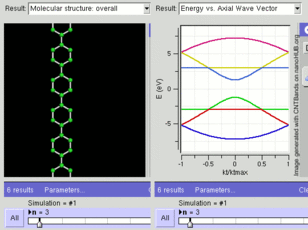
Tiny nanoribbons of carbon could be used to make a magnetic field sensor for novel electronic devices
Researchers in Singapore have designed an electronic switch that responds to changes in a magnetic field. The device relies on graphene, a strong and flexible electricity-conducting layer of carbon atoms arranged in a honeycomb pattern.
Seng Ghee Tan of the A*STAR Data Storage Institute, along with colleagues at the National University of Singapore, used theoretical models to predict the properties of their proposed device, known as a magnetic field-effect transistor.
The transistor is based on two nanoribbons of graphene, each just a few tens of nanometers wide, which are joined end to end. The atoms along the edges of these nanoribbons are arranged in an ‘armchair’ configuration — a pattern that resembles the indented battlements of castle walls. If these edges were in a zigzag pattern, however, the material would have different electrical properties.
One of the nanoribbons in the team’s transistor acts as a metallic conductor that allows electrons to flow freely; the other, slightly wider, nanoribbon is a semiconductor. Under normal conditions, electrons cannot travel from one nanoribbon to the other because their quantum wavefunctions — the probability of where electrons are found within the materials — do not overlap.
A magnetic field, however, warps the distribution of electrons, changing their wavefunctions until they overlap and allowing current to flow from one nanoribbon to the other. Using an external field to change the electrical resistance of a conductor in this way is known as a magnetoresistance effect.
The team calculated how electrons would travel in the nanoribbons under the influence of a 10-tesla magnetic field — the rough equivalent of that produced by a large superconducting magnet — at a range of different temperatures.
The Latest Bing News on:
Magnetic switch
- Report: Nintendo shows off Switch 2 to partners who were only able to feel, not see, the systemon April 30, 2024 at 3:57 pm
Sources in attendance tell Vandal that the next-generation Switch device would have magnetic joycons. This would replace the base Switch's rail system, and, depending on the sound that the controllers make when attached, could even change Nintendo's ...
- What the Most Credible Leaks Say About the Nintendo Switch 2on April 30, 2024 at 2:30 pm
The Switch 2 is full of rumors, many of them likely bogus, However, some rumors are more solid than others, and it gives us a look at what Nintendo's upcoming console might be like.
- Your Nintendo Switch is about to become massively inferior - and in more ways than oneon April 30, 2024 at 12:12 am
According to YouTube influencer Doctre81, the Nintendo Switch 2 will also use faster chips developed by Samsung. Specifically, the Switch 2 will reportedly use Samsung's fifth-generation V-NAND chips, which have a 1.4 GB/s data transfer rate.
- Switch 2 Rumored to Have Magnetic Suction Based on Claims From Third-Party Controller Manufactureron April 29, 2024 at 11:20 am
N intendo’s Switch successor console, referred to by many as the “Switch 2,” will feature magnetic Joy-Con controllers, backward compatibility, and a host of other new features, according to the latest batch of rumors.
- Nintendo Switch 2 Joy-Cons tipped for major upgrade – extra buttons and a surprising new techon April 29, 2024 at 8:00 am
A peripheral company has spilled the beans on the Nintendo Switch 2 – namely its upgraded Joy-Cons. It claims that the next-gen console will have larger controllers than its pre
The Latest Google Headlines on:
Magnetic switch
[google_news title=”” keyword=”magnetic switch” num_posts=”10″ blurb_length=”0″ show_thumb=”left”]
The Latest Bing News on:
Graphene Nanoribbons
- Graphene in Biomedicine: Opportunities and Challengeson April 27, 2024 at 5:00 pm
Graphene, whose discovery won the 2010 Nobel Prize in physics, has been a shining star in the material science in the past few years. Owing to its interesting electrical, optical, mechanical and ...
- Is it Worth Investing in Graphene?on April 25, 2024 at 5:00 pm
For example, in electronics, graphene nanoribbons can be engineered into high-performance (400 meV band gaps) semiconductors, enabling the development of advanced field-effect transistors. Gaphene's ...
- Local twist angles in graphene come into viewon April 18, 2024 at 5:00 pm
The new technique revealed pronounced variations in local twist angles in twisted bilayer graphene. (Courtesy: S Zhu) Stacking layers of two-dimensional materials on top of each other and varying the ...
- Goldene: New 2D form of gold makes graphene look boringon April 17, 2024 at 12:29 am
Graphene is a bit like the Novak Djokovic of materials – it’s so damn talented that each new achievement feels passé. But now, an exciting new upstart is challenging graphene’s title.
- Quantum electronics: Charge travels like light in bilayer grapheneon April 15, 2024 at 5:00 pm
In graphene, however, such a "switch" in the speed of the carrier cannot be easily achieved. In fact, graphene usually has no insulating state, which has limited graphene's potential a transistor.
- The Future of Electronics is Here: How Georgia Tech’s Innovative Graphene Chip Technology Transforms the Fieldon March 7, 2024 at 1:58 am
“There has been some success with graphene nanoribbons, but in principle this technology is very similar to semiconducting carbon-nanotube technology which has not been successful after 30 years ...
- Revolutionizing Technology: The Advent of Georgia Tech’s Innovative Graphene Chipon March 5, 2024 at 4:46 am
“There has been some success with graphene nanoribbons, but in principle this technology is very similar to semiconducting carbon-nanotube technology which has not been successful after 30 years ...
- Graphene Nanoribbons From Merckon November 29, 2023 at 6:33 am
Let us help you with your inquiries, brochures and pricing requirements Request A Quote Download PDF Copy Request A Quote Download PDF Copy Request A Quote Download ...
- $1 Graphene Sensor Identifies Safe Wateron August 29, 2023 at 7:28 pm
Scientists have reported a graphene sensor they say costs a buck and can detect dangerous bacteria and heavy metals in drinking water. The sensor uses a GFET — a graphene-based field effect ...
- Carbon Nanotube and Graphene Device Physicson June 14, 2023 at 2:07 am
Chen, Pai-Yen and Alu, Andrea 2013. Terahertz Metamaterial Devices Based on Graphene Nanostructures. IEEE Transactions on Terahertz Science and Technology, Vol. 3, Issue. 6, p. 748. Nguyen, Ngoc Hieu ...
The Latest Google Headlines on:
Graphene Nanoribbons
[google_news title=”” keyword=”Graphene Nanoribbons” num_posts=”10″ blurb_length=”0″ show_thumb=”left”]











